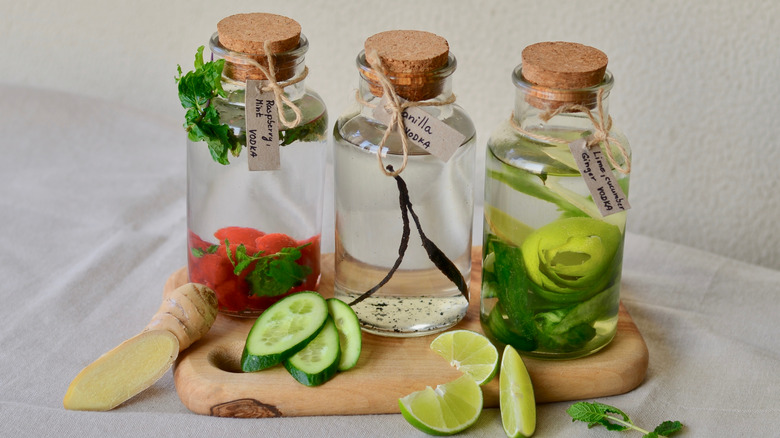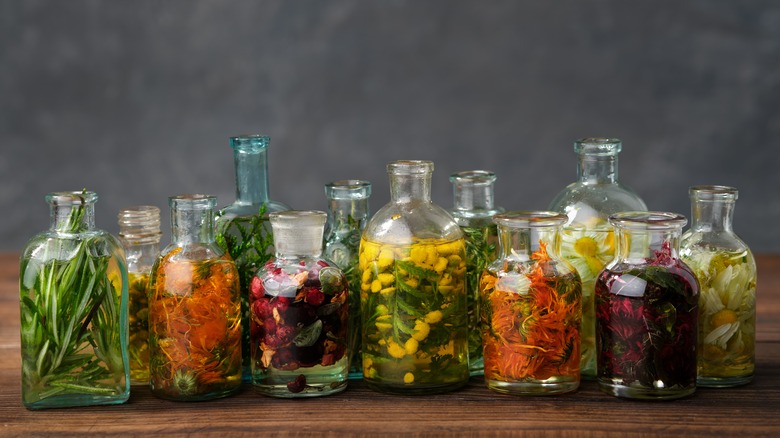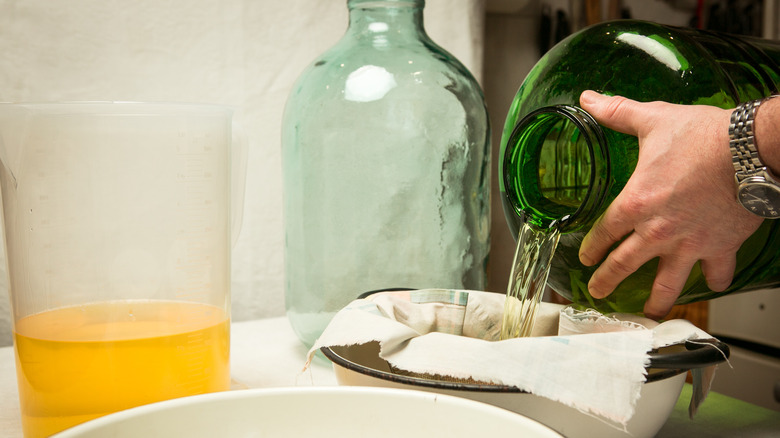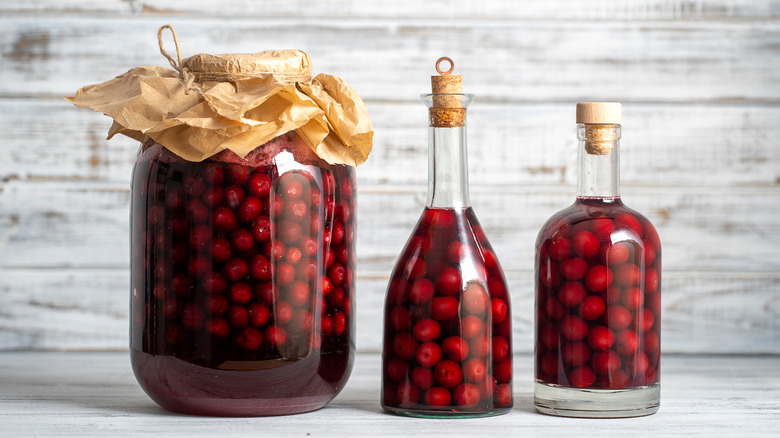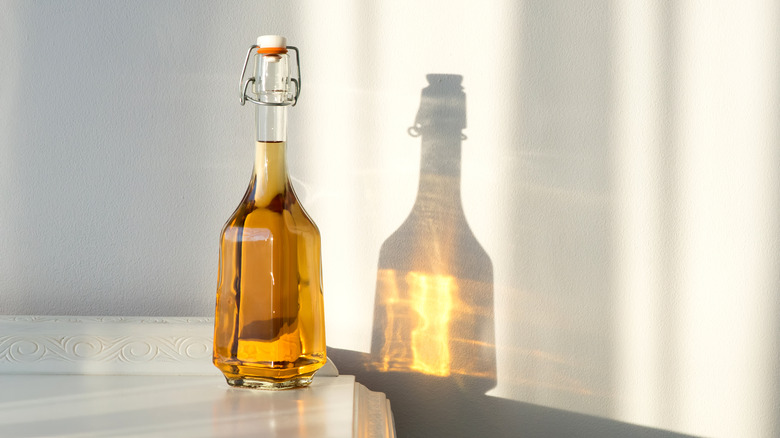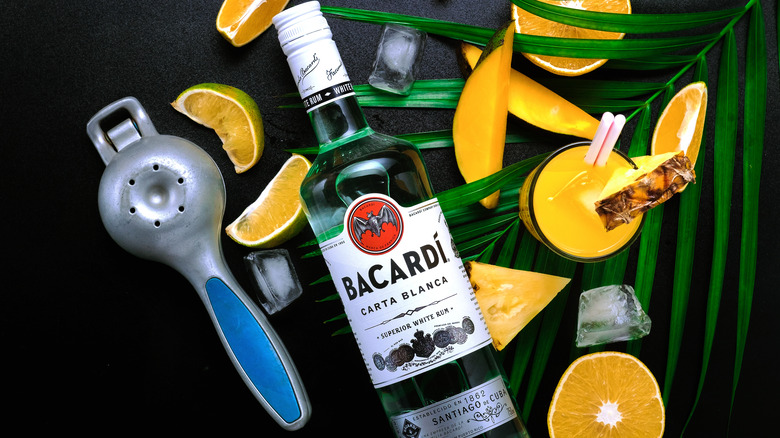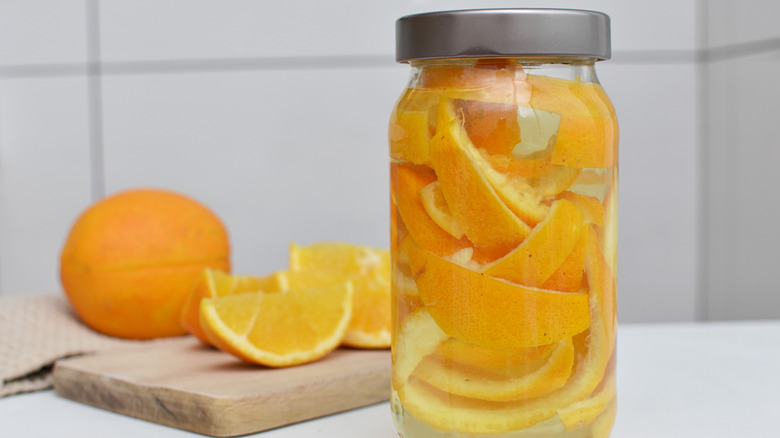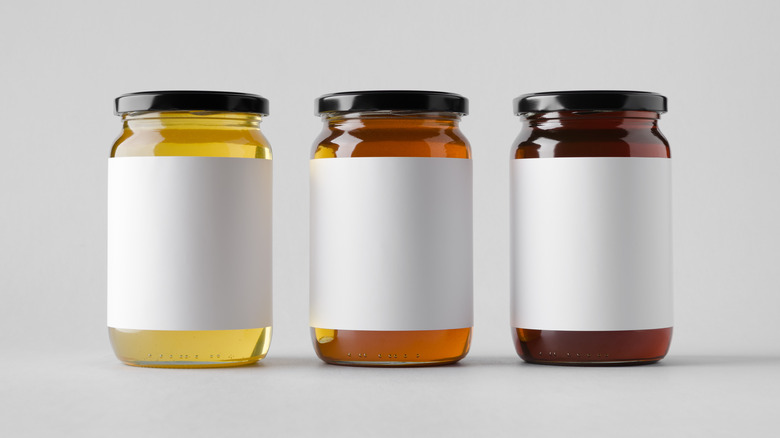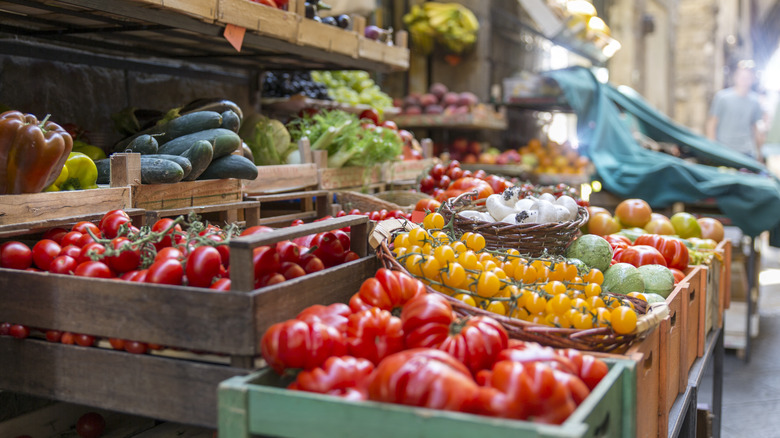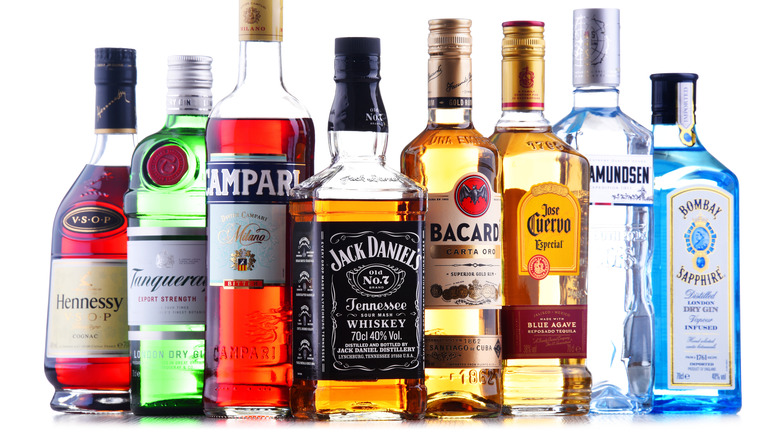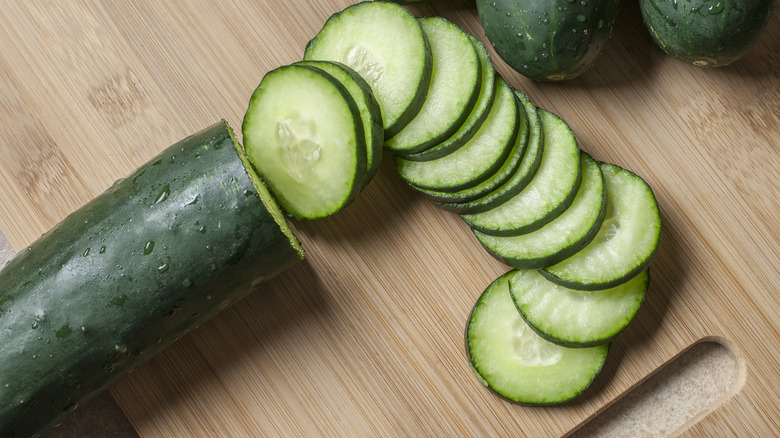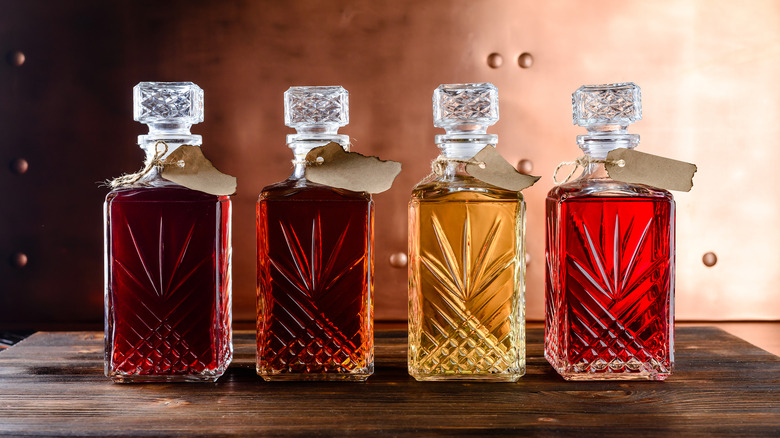Mistakes You Need To Avoid When Making Your Own Drink Infusions
When it comes to flavored alcohols, brands like Absolut Vodka and Tanqueray Gin make an extensive array of liquors that line the shelves of bars and supermarkets around the world. So why is it that professional bartenders and home mixologists continue to make their own drink infusions?
To start, making a custom infusion is likely to be cheaper than buying a commercially available product — and bartenders are able to boast about unique housemade infusions while using extra ingredients gleaned from their colleagues in the kitchen (per Wine Enthusiast). Dave Arnold, cocktail maker and founder of the Museum for Food and Drink, says, "Making your own infusion allows you to put your own stamp on things and offer something no one else has" (via The New York Times).
Adding to that, the process of infusing spirits is simple enough. The Los Angeles Times states that infusions are made by letting fruits, vegetables, or spices (or a combination) sit in Mason jars or containers of alcohol set in a location away from heat or moisture. When the flavors have been infused into the alcohol, it is then strained and stored. With only a bottle of alcohol, simple equipment, and whatever edible ingredients that tickle your fancy, you can make unique flavored alcohols for cocktails or to bottle as gifts. But before you jump headfirst into the world of infused spirits, here are some mistakes you should avoid when making your own drink infusions.
1. Letting it infuse for too long
You may be tempted to let your ingredients sit in the alcohol for as long as possible. After all, jars of flowers and fruit floating in vodka seem incredibly appealing, and shouldn't a longer infusing time equal a more flavorful infusion? Not quite. Just like how letting your tea leaves sit in hot water for too long can cause your brew to become bitter, excessive soaking times may also ruin your infusion. In an article with Mic, bar and restaurant owner Laura Sanfilippo states that infusing your ingredients for too long extracts undesirable flavors.
Now, you may be wondering what the ideal length of time to infuse is. Infusion times for different ingredients vary — milder tasting fresh fruit like mango and strawberry take at least a week, while stronger flavors such as chillies, spices, and citrus peels may be ready in days, or even several hours (via CityScope). Sanfilippo recommends tasting your infusion often to check on its progress, and straining it once it reaches the desired intensity to prevent over-extraction.
If you happen to be busy and are unable to constantly check on your infusion, a tip given by Edible Manhattan is to place your jar or container into the refrigerator. Lower temperatures slow the rate of infusion, and buys you extra time before over-extraction occurs.
2. Not straining your infusions properly
After determining the sweet spot where your infusion has reached the perfect flavor, the next step is to strain the ingredients out of the liquid and store it. Here, you may reach for a regular strainer to remove the large chunks of fruit or vegetables bobbing around in your alcohol, and then call it a day.
However, just straining it once through a sieve is not enough to get rid of all the ingredient particles in your infusion. Punch explains that as time passes, the remaining sediment turns your infusion cloudy and unattractive, and increases the risk of spoilage or development of unwanted flavors. In order to remove the excess particles in your infusion, BBC Goodfood recommends straining out the larger pieces of ingredients with a sieve, then running the liquid through a coffee filter or muslin cloth. The finer mesh of these filters are much more capable of trapping the smaller fragments that may ruin your infusion in the long run.
3. Making a large batch when trying new flavors
Experimenting with ingredients or a different type of alcohol in your infusion holds the promise of an exciting new flavor to impress your friends and family with. But it may also end up as an unappealing concoction that you have no choice but to pour down the kitchen sink.
Perhaps you forgot to scrape out the seeds of that habanero pepper and created a vodka infusion that was way too spicy. Or the raspberries you used were too ripe, infusing your gin with unpleasant fermented notes. Maybe the durian infused rum you dreamt up in a fit of mad genius turned out to be more madness than genius.
The one thing that worsens the disappointment of your infusion not turning out the way you expected it to is having to throw out a whole bottle's worth of alcohol and other ingredients. When trying a recipe for the first time or playing around with new flavors, it is always wise to start with a small batch. Jo Farish from The Gin Garden recommends basing your experiment's recipe on a quarter bottle of your spirit of choice whenever you try something new (via BBC Goodfood). This way, you aren't stuck sipping a whole liter of eye-watering chili vodka, and also end up with less waste if your infusion turns out undrinkable.
4. Poor storage of your infusions
You've made an infusion that is perfect — its flavors are well-balanced and at the ideal intensity. It is delicious and inspires a dozen different cocktail ideas, but life gets in the way, and you are only able to crack that jar open again a month later. Tasting it, you find that the flavors have changed, becoming unpleasant and completely different from when you strained and stored it.
This change in flavor is probably due to the improper storage of your infusions. Infusions should be stored the same way their alcohol bases are — in a cool, dry space away from sunlight. Speaking to Wine Enthusiast, Dr. Bill Lumsden, Ardbeg, explains that prolonged exposure of a spirit to high temperatures and sunlight can cause evaporation of alcohol, and the oxidation of certain components in the spirit, resulting in a rancid flavor. To err on the side of caution and prolong the shelf life of your infusion, Punch suggests keeping your infusion chilled in the refrigerator.
5. Pairing the wrong ingredients with your spirits
Vodka is often the medium of choice when taking the first step into the world of infusions. Federico Avila, general manager of Bar Belly, calls vodka a "blank canvas" (via Chilled). He explains that its popularity as a beginner spirit for infusions is due to its lack of flavor, where it easily assumes the flavor of a variety of ingredients. Other spirits, such as gin — itself an infusion flavored with botanicals — or whiskey, tend to be more difficult to pair, as they have more complex flavor profiles that may clash with certain ingredients. Though gin does pair well with citrus, Avila adds.
If you wish to venture out of the comforting neutrality that vodka provides, remember to keep the flavors of your base spirit in mind when choosing the ingredients for your infusion. Wine Enthusiast provides some advice for pairing ingredients with spirits other than vodka — the earthy notes found in tequila and mezcal go well with ingredients like cucumbers, citrus, and chillies. Rum loves fruit infusions, whiskey appreciates being paired with warm spices, vanilla, and dried fruit — while the herbaceous and fragrant flavors in gin are unsuitable to combine with additional spices and herbs.
Not sure where to start? Take inspiration from existing combinations of spirits and flavors that are used in cocktails, baked goods and dishes. Rum and ginger, whiskey and apple, gin and cucumber are all good examples of classic pairings that exist in other forms, and will translate well to infusions.
6. Not shaking your infusion
A common step you will see in guides on making infused spirits is an instruction to shake your infusing vessel at least once a day. Don't skip this simple step! A gentle shake every few hours or every day helps to hasten the process of infusion. According to Difford's Guide, it is a technique that is also applied in the commercial production of infused spirits, with big rotating tanks that help agitate the mixture.
Keivan Nemati, author and ambassador to Brockmans Gin, also explains that shaking a spirit in the process of being infused plays a part in preventing oxidation. If the ingredients infusing in the alcohol have a tendency to float, shaking the mixture helps them settle back to the bottom of the jar where they will no longer be exposed to air at the surface. This stops the material from oxidizing, and prevents any off-flavors from developing in the infusion.
7. Failing to label and take notes
If you've caught the infusing bug, your collection of infusions may be growing at an alarming rate. Jars of vodka, gin, and whiskey clutter your cupboard or refrigerator, and you start to lose track of what each container holds. This is why labeling your infusions is an essential step in the process. Bartender Amanda Wan (via Lifestyle Asia) stresses the importance of labeling each container (or writing notes), stating that this prevents anything from being thrown away by accident, and provides a reminder of what the jar contains. She recommends being precise, writing down the exact amounts of ingredients that went into the jar, as well as the time and date the infusion was started.
This level of precision also allows you to more accurately recreate successful infusions that you enjoyed. It ensures consistency across future batches, and won't leave you scratching your head as you try to remember whether it was a whole pineapple or only half for that pineapple infused vodka you made six months ago.
8. Using poor quality ingredients
It comes as no surprise that if you use poor quality ingredients, you get a poor quality infusion. Much like making a cake with margarine and old eggs results in a much less tasty cake than one made with butter and fresh ingredients, an infusion is more likely to succeed with good quality components.
As the main component of an infusion, the liquor you choose should be one that you'd be happy to drink unadulterated, as infusing a bottom shelf bottle will not do much to improve it. As The Los Angeles Times puts it: "A cheap bottle of liquor will still taste like drain cleaner no matter how much mint you shove in the bottle."
Additionally, keep an eye on the condition of your infusing ingredients. Spices that have been sitting in your cupboard for years may not impart much flavor, and the level of ripeness in fresh fruits and vegetables can also affect your infusion. Edible Manhattan explains that overripe fruit often results in an infusion that has "an oxidized flavor and color," while underripe fruit has under-developed flavor, producing a bland and weak infusion. When using fresh fruits, vegetables and herbs, The Spice House also reminds beginner mixologists to clean their produce thoroughly, as remaining soil or dirt can impart undesirable flavors to the infusion.
9. Using expensive alcohol
While the quality of the liquor used is important in creating a good infusion, it is not recommended that you splurge on bottles from the top shelf. A mid-range bottle of spirit is much more suitable for any infusion projects you have in mind.
Speaking to The Denver Post, recipe developer Toni Dash states that using an affordable spirit of decent quality is the way to go, as infusing it will improve its flavor. On the other hand, using a bottle of the highest quality ends up being a bit of a waste, as infusions will mask the natural flavors and characteristics that allow the spirit to command high prices in the first place. The Distillery of Modern Art points out that "high-end spirits are carefully constructed, and any infusions of flavor will only throw off their delicate balance." Additionally, if your infusions don't go as planned and you produce an unpalatable concoction, you will end up with a lot more money going down the kitchen sink while using expensive spirits.
10. Leaving your produce whole
The process of making your own drink infusions with fresh produce like herbs, fruits, and vegetables is simple — after all, throwing in several strawberries or sprigs of rosemary in a jar and covering them with vodka is hardly complicated. However, it is good to note that by taking additional steps in preparing your ingredients helps to improve the flavor of your infusions.
When it comes to bigger fruits and vegetables like apples or cucumbers, HGTV recommends cutting them into smaller pieces in order to expose a greater surface area and allow the alcohol to extract flavors more easily. You may also consider only using certain parts of the produce that contain the most flavor, and omit others that may impart unwanted notes. For example, Imbibe suggests removing the bitter pith from citrus rinds with thick skins, or peeling the outer layer of skin from root vegetables like beets and ginger to achieve a cleaner and more concentrated flavor. Neil Grosscup, CEO of Tanteo Spirits, tells Mic that using a whole piece of fruit often produces "a cacophony of flavor," and using fewer components of a fruit can produce cleaner flavors in your infusion.
11. Only limiting your infusions to one ingredient
The beauty of making your own drink infusions is that you can create anything you want. Unexpected flavor combinations that are impossible to find ready-made on the shelves become a challenge for you to experiment with. Although single-ingredient infusions are easier to make and pose less of a risk of things going wrong, you would be making a mistake in avoiding multi-ingredient infusions. They often have more complexity in flavor, and give you room for more original ideas. Imbibe suggests taking inspiration from food combinations you already love — like making a basil, tomato, and oregano vodka infusion as a tribute to pizza.
Once you have some experience making your own infused spirits and feel comfortable in creating single-ingredient infusions, go ahead and try combining different ingredients. When making an infused liquor with multiple ingredients, CityScope advises staggering the infusion of ingredients. The ingredient with the lightest flavor should be infused first, and when the desired intensity is achieved, it should be strained out and the next ingredient added to infuse.
Making your own drink infusions open up a world of possibilities limited only by your creativity, and perhaps your wallet. You may not always succeed in creating the perfect combination, but chances are that with a little practice, you will be able to come up with unique and delicious infusions not found elsewhere.
